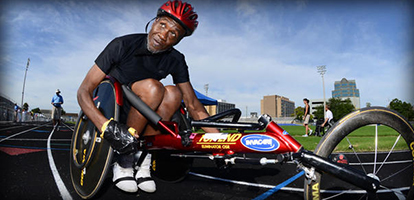Opening Day at the Perelman School of Medicine
Scenes from the White Coat Ceremony
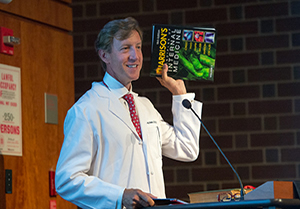 With props from the past - several hefty medical textbooks - and the svelte iPad that has replaced them, Dean J. Larry Jameson welcomed the Parents and Partners audience to the reality of lifelong learning that awaits Perelman School students.
With props from the past - several hefty medical textbooks - and the svelte iPad that has replaced them, Dean J. Larry Jameson welcomed the Parents and Partners audience to the reality of lifelong learning that awaits Perelman School students.
Following the morning's preview of medical school life, the August 15 White Coat Ceremony marked the symbolic beginning of their medical careers. The richly talented, diverse, energetic group of future Penn doctors hails from 33 states across the U.S., as well as Puerto Rico, Peru, Pakistan, and other countries. They range in age from 20 to 30 years old, with several master’s degrees and varied educational degrees among them. The class is nearly one-half women and about 25% minorities underrepresented in medicine.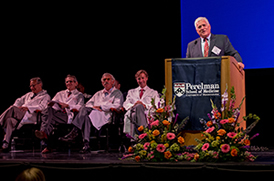
The Class of 2018 (and those starting school now but planning to stay at Penn longer to complete additional degrees) differs from its predecessors in one important way. They are the only group to be starting medical school here during celebration of the 250th anniversary of the School.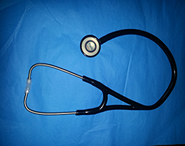
Keynote speaker and infectious disease expert Harvey Rubin, MD, PhD, highlighted the great, and greatly appreciated, impact of Perelman School faculty and students by describing his work against vaccine-preventable illnesses. The project began with a late-night e-mail from his neighbor, actor David Morse, on a troubling topic. Morse was wondering, while watching CNN coverage of his friend Sean Penn carrying a dying Haitian child, why anyone would be dying of diphtheria in this day and age. In fact, 3 million children under 5 die every year from vaccine-preventable illnesses, often because vaccines must be refrigerated at between 2-8 C, to remain viable.
Dr. Rubin realized a practical solution was at hand. Cell 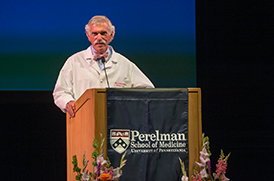 phones are widely used in the developing world, which in many places skipped landline technology altogether, and cell tower networks could provide an inexpensive, accessible, sustainable and locally managed source of power for refrigeration. Energize the Chain (ETC), a company Dr. Rubin helped to create, along with his student Alice Conant and others, is implementing this approach. Already in Zimbabwe, their efforts have led to the vaccination of more than 250,000 children. Vaccination plans are underway throughout Africa.
phones are widely used in the developing world, which in many places skipped landline technology altogether, and cell tower networks could provide an inexpensive, accessible, sustainable and locally managed source of power for refrigeration. Energize the Chain (ETC), a company Dr. Rubin helped to create, along with his student Alice Conant and others, is implementing this approach. Already in Zimbabwe, their efforts have led to the vaccination of more than 250,000 children. Vaccination plans are underway throughout Africa.
Invoking the movie Miracle, about the 1980 US hockey team, Dr. Rubin closed by reminding the assembled students that while they’re on the Penn team now, they play for humanity and should go out and make their mark to improve the human condition.
On Our 250th
Q & A With Celebration Co-Chair Rosemary Mazanet, GR'81, M'86, PAR'11
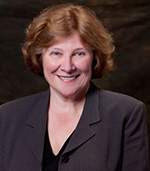 “At Penn, you can see the whole history of American Medicine. All you have to do is walk across our campus.”
“At Penn, you can see the whole history of American Medicine. All you have to do is walk across our campus.”
Dr. Mazanet, proud Penn Medicine alumna, parent, and trustee, agreed to be first in this series of flash interviews.
Q: What stands out among your student experiences at Penn?
A: Our access to the legends in science and medicine was almost shocking to me. You read their papers and their textbooks, but you never expected to work shoulder to shoulder with them. But they were always there for us -they would teach you as much as you could stand, teach you until it hurt.
People like Truman Schnabel, a physician’s physician, and well known in the Philadelphia area. He provided wonderful instruction in patient interaction, delicate but effective engagement. Britton Chance was an international superstar and you could run into him on campus. Ernie Rosato was tremendously giving of his time, to students, as was Donald Martin in medicine.
I felt as though I had hit the jackpot the day I was with transplant pioneer Clyde Barker; when he was called to perform a kidney transplant, I got to hold retractors. I had unbelievable opportunities to learn from eminent surgeons, even though we all knew I wasn’t planning to go into surgery.
Our training measured up extremely well, in my experience. That is, I came to feel that we had better training than other colleagues I later encountered. So, Penn gave us the opportunity to be A-list professionals.
Q: You have served on the Penn Medicine board since 2002. What are the most significant changes you’ve seen?
A: The University and the School have made great efforts to further integrate and foster an environment of collaboration. The ability of students and faculty to work beyond their departments and schools is extraordinary and built in from the beginning. I think that Penn is an even more fertile locus for collaboration and impact now.
The student-friendly innovations in the learning and living environment, the state-of-the-art facilities, stellar faculty recruitments, and continuing groundbreaking discoveries are all inspiring.
And this motivates me to stay involved. I cherish the opportunities that Penn gave me and am delighted to be able to give back.
Q: What are you most looking forward to about the 250th celebrations?
A: Reminding everyone that we were first! If we didn’t establish departments or procedures first, we were early adopters. And did I mention there will be fireworks?
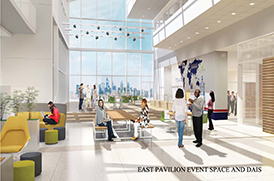 I’m most looking forward to the ribbon cutting for the Jordan Center [the Henry A. Jordan M’62 Medical Education Center]. I was very influenced by Henry Jordan and his great willingness to be involved, to be part of the solution, part of the process. I loved how he interacted with everyone here and how he saw this as a mission. He became my role model.
I’m most looking forward to the ribbon cutting for the Jordan Center [the Henry A. Jordan M’62 Medical Education Center]. I was very influenced by Henry Jordan and his great willingness to be involved, to be part of the solution, part of the process. I loved how he interacted with everyone here and how he saw this as a mission. He became my role model.
The Jordan Center, juxtaposed on campus with classic buildings, particularly the John Morgan Building, represents how we take the best from the past as we forge ahead into the future of medical training and practice.
Please see our website dedicated to the 250th for more information on the School's 250th celebrations.
Elliot Stein, M'19, Hits the Ground... Riding
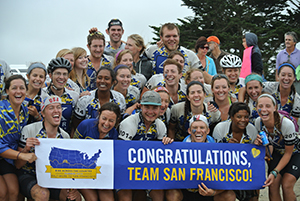 The Ride to Conquer Cancer gained first-year student Elliot Stein as a participant even before he donned his white coat. “After reading about the challenge this summer,” he said, “I knew I had to do it.”
The Ride to Conquer Cancer gained first-year student Elliot Stein as a participant even before he donned his white coat. “After reading about the challenge this summer,” he said, “I knew I had to do it.”
In July, Mr. Stein joined six other students on the “Perelman School of Medicine Students” team for the Ride to Conquer Cancer. He heard about the ride, which will benefit Penn Medicine’s Abramson Cancer Center, on the Class of 2019 Facebook page through fellow first-year student Charlie Santos. Each rider aims to raise at least $2,500.
Such health-oriented volunteer service is part of Elliot’s focus as he embarks on his medical training. He is ambitious and was especially attracted by the Perelman School’s dual degree programs, the curriculum, and its high-caliber faculty and students. “I feel that Penn will teach us to become excellent clinicians but also empower us to advance the frontiers of medicine in whichever field we choose to enter,” he said.
Elliot will Ride to Conquer Cancer practically on the heels of another major charity ride, the 4K for Cancer. This ride took him from Baltimore to San Francisco. Riders on four different cycling routes raised over one million dollars for young adults affected by cancer. While en route, riders had 10 service days during which they often volunteered at cancer centers, Hope Lodges, Ronald McDonald Houses, and similar facilities.
As for the Ride to Conquer Cancer, the experienced cyclists on the Perelman team will help train their mostly novice team members, with a group ride of the full 75-mile course expected prior to the official Ride. Any Perelman School students interested in joining the team should email Elliot at Elliot.Stein@uphs.upenn.edu for detailed instructions. To learn more or to support this medical student student team, please click here.
A Philly First
Philadelphia Veterans Medical Center Hosts World's Largest Wheelchair Games
With seventeen competitive athletic events, including archery, quad rugby, and power soccer, the 34th National Veterans Wheelchair Games is “the opportunity of a lifetime,” according to Elena Newland, PT, DPT, at Good Shepherd Penn Partners.
Ms. Newland was the event’s assistant and sport lead for the track event of the Games. The games produce champions, improve health, and give inspiration. Many of the week's volunteers came from Penn Medicine, including students from Penn Medicine's High School pipeline program.You can read more here:
August 25, 2014 Penn Medicine News Blog.
August 13, 2014 Philadelphia Inquirer article.
August 17, 2014 Philadelphia Inquirer article.
